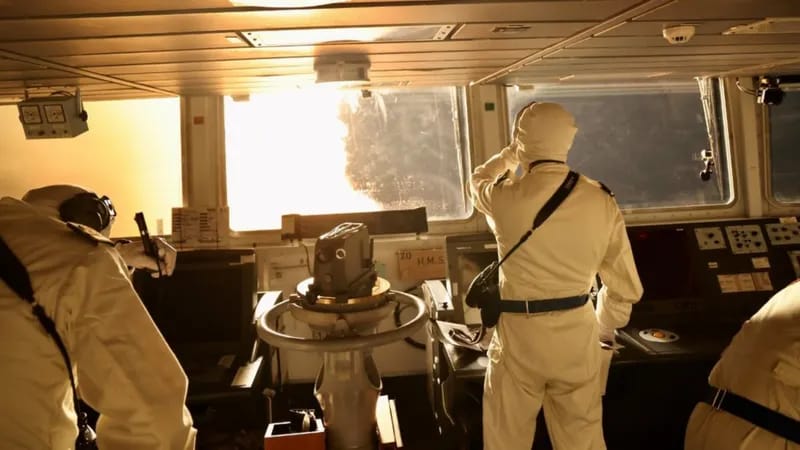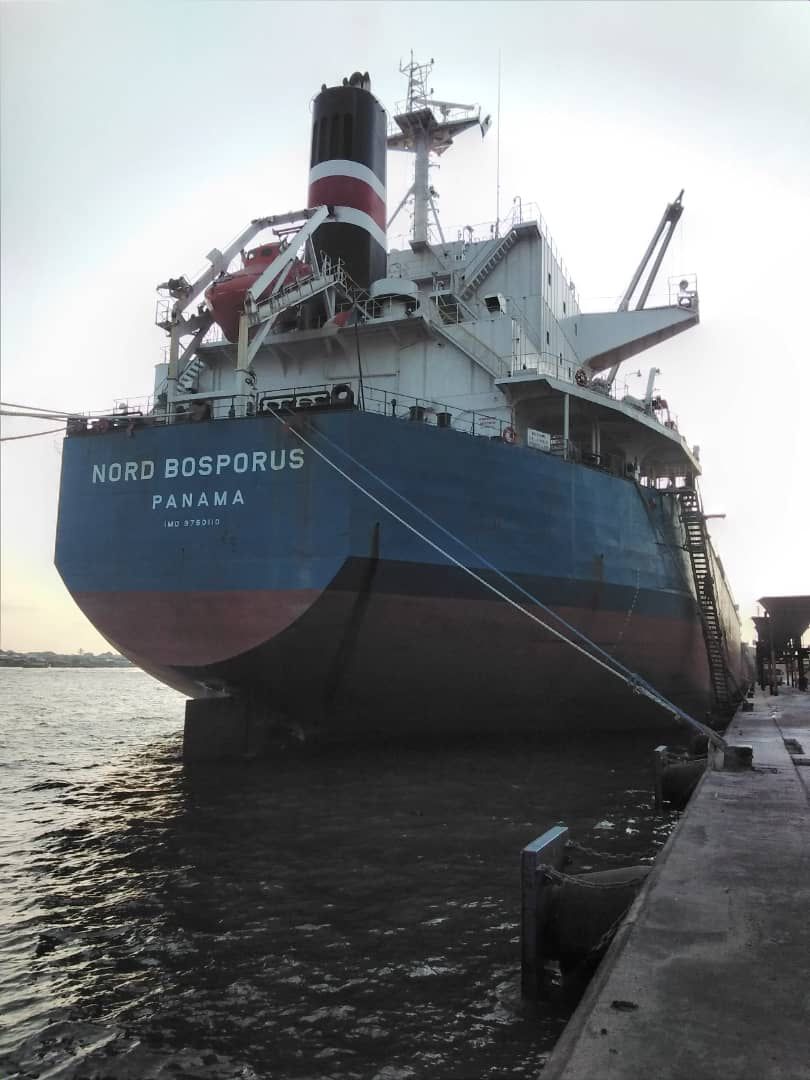US and UK hint at military action after largest Houthi attack in Red Sea
6 min read
US and UK hint at military action after largest Houthi attack in Red Sea
By Admin
The UK’s Ministry of Defence shared images of the HMS Diamond deploying Sea Viper missiles and guns
The US and UK have hinted they could take military action against Yemen’s Houthi rebels, after they repelled the largest attack yet on Red Sea shipping.
Carrier-based jets and warships shot down 21 drones and missiles launched by the Iran-backed group on Tuesday night.
The allies warned of “consequences” for such attacks. Asked about potential strikes in Yemen, UK Defence Secretary Grant Shapps said: “Watch this space.”
The Houthis said they targeted a US ship providing support to Israel.
The have repeatedly claimed – often falsely – that they are attacking merchant vessels linked to Israel in protest at Israeli actions during the war in Gaza.
Houthis defiant after warning over Red Sea attacks:
Tuesday’s attack was the 26th on commercial shipping in the Red Sea since 19 November.
The US military said Iranian-designed one-way attack drones, anti-ship cruise missiles and anti-ship ballistic missiles were launched from Houthi-controlled areas of Yemen at around 21:15 local time (18:15 GMT).
Eighteen drones, two cruise missiles and one ballistic missile were shot down by F/A-18 warplanes from the aircraft carrier USS Dwight D Eisenhower, which is deployed in the Red Sea, and by four destroyers, the USS Gravely, USS Laboon, USS Mason and HMS Diamond.
HMS Diamond shot down seven of the Houthi drones using its guns and Sea Viper missiles, each costing more than £1m ($1.3m), a defence source said.
No injuries or damage were reported.
Later, Houthi military spokesman Yahya al-Sarea confirmed its forces had carried out an operation involving “a large number of ballistic and naval missiles and drones”.
“It targeted a US ship that was providing support for the Zionist entity [Israel],” he said.
“The operation came as an initial response to the treacherous assault on our naval forces by the US enemy forces,” he added, referring to the sinking of three Houthi speed boats and killing of their crews by US Navy helicopters during an attempted attack on a container ship on 31 December.
He added that the rebels would “not hesitate to adequately deal with all hostile threats as part of the legitimate right to defend our country, people and nation”.
Mr Sarea also reiterated that the Houthis would continue to “prevent Israeli ships or ships heading towards occupied Palestine from navigating in both the Red Sea and the Arabian Sea until the [Israeli] aggression [on Gaza] has come to an end and the blockade has been lifted”.
A spokesperson for UN Secretary General Antonio Guterres said he was “very concerned” because of the risks the situation posed to global trade, the environment and lives, as well as the “risk of the escalation of the broader conflict in the Middle East”.
The UN Security Council is expected to vote on a resolution on Wednesday evening demanding the Houthis stop targeting maritime traffic in the Red Sea.
‘Direct action possibly imminent’
Something has to change in the Red Sea. The current situation is unsustainable, both economically and militarily. From a purely fiscal standpoint there is a massive mismatch between the cost of a Houthi drone (roughly £17,000) and a Royal Navy Sea Viper missile (£1m plus) used to destroy incoming missiles.
Different weapons are used by both sides, with the Houthis also deploying more expensive anti-ship ballistic missiles and uncrewed surface vessels (USVs), ie explosive boat drones. But thanks to Iranian help, the Houthis have a large supply of missiles and drones that they can use in a “swarm attack”, hoping to overwhelm the air defences of Western warships.
A new report today by the UK defence think tank Rusi says the Houthis are likely being provided with intelligence by an Iranian surveillance ship in the Red Sea, the MV Behshad.
The pressure on the crews of warships now deployed on the US-led Operation Prosperity Guardian in the Red Sea is also immense. As former Royal Navy commanders have pointed out, there can be as little as 30 seconds’ warning between the detection of an incoming supersonic missile and its impact.
These are all reasons why, if the Houthis persist in these attacks, then direct military action against them is possibly imminent.
Mr Shapps warned in a statement on Wednesday morning that the UK and its allies had “previously made clear that these illegal attacks are completely unacceptable and if continued the Houthis will bear the consequences”.
“We will take the action needed to protect innocent lives and the global economy,” he added.
Later, the defence secretary said in a TV interview that Iran was “behind so much of the bad things happening in the region” and warned the Islamic Republic and the Houthis that there would be “consequences” if the attacks on shipping did not stop.
Asked if there could be Western military action against Houthi targets in Yemen, or even targets inside Iran, he replied: “I can’t go into details but can say the joint statement we issued set out a very clear path that if this doesn’t stop then action will be taken. So, I’m afraid the simplest thing to say [is] ‘watch this space’.”
He was referring to a statement put out a week ago by the UK, US, Australia, Bahrain, Belgium, Canada, Denmark, Germany, Italy, Japan, Netherlands, New Zealand, South Korea and Singapore, who launched “Operation Prosperity Guardian” last month to protect Red Sea shipping.
They said the attacks posed “a direct threat to the freedom of navigation that serves as the bedrock of global trade in one of the world’s most critical waterways”.
It may not have had the bravado of Mr Shapps’ “watch this space” warning, but US Secretary of State Antony Blinken was also clear in his condemnation of the incident.
Speaking to reporters at an airport in Bahrain during a Middle East tour, he was pressed by BBC North America correspondent Anthony Zurcher about whether it was time that talk of consequences turned to US action.
Mr Blinken responded that he did not want to “telegraph” a US military move, but that he had spent the past four days in the region warning the Houthis to cease their aggression.
They have not only refused, but after this latest strike have claimed they are specifically targeting US ships.
While he may have declined to go into details, our correspondent says it is becoming increasingly difficult to imagine that the “consequences” and the “response” Mr Blinken discussed in Bahrain will not translate into a use of military force.
Almost 15% of global seaborne trade passes through the Red Sea, which is linked to the Mediterranean by the Suez canal and is the shortest shipping route between Europe and Asia.
The fear is that fuel prices will rise and supply chains will be damaged.
The International Chamber of Shipping says 20% of the world’s container ships are now avoiding the Red Sea and using the much longer route around the southern tip of Africa instead.
The Houthis say they have been targeting Israeli-owned or Israel-bound vessels to show their support for the Iran-backed Palestinian group Hamas since the start of the war in Gaza in October.
Formally known as the Ansar Allah (Partisans of God), the Houthis began as a movement that championed Yemen’s Zaidi Shia Muslim minority.
In 2014, they took control of the capital, Sanaa, and seized large parts of western Yemen the following year, prompting a Saudi-led coalition to intervene in support of the international-recognised Yemeni government.
The ensuing war has reportedly killed more than 150,000 people and left 21 million others in need of humanitarian assistance.
Read Also:Gloria Maya Musu-Scott: Liberia’s ex-chief justice sentenced to life for murder
Saudi Arabia and the US have accused Iran of smuggling weapons, including drones and cruise and ballistic missiles, to the Houthis in violation of a UN arms embargo. Iran has denied the allegation.
Source: BBC News




